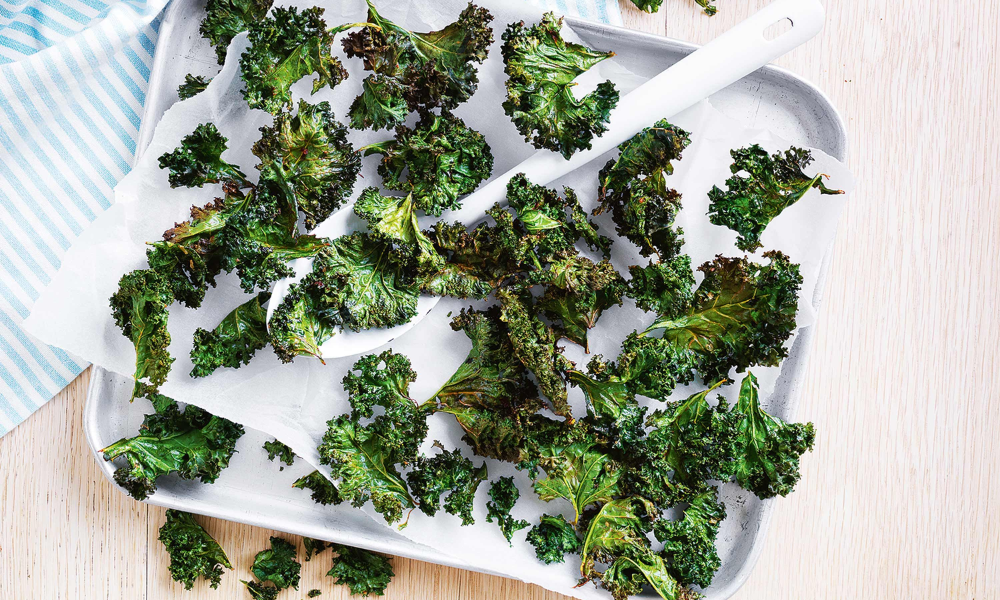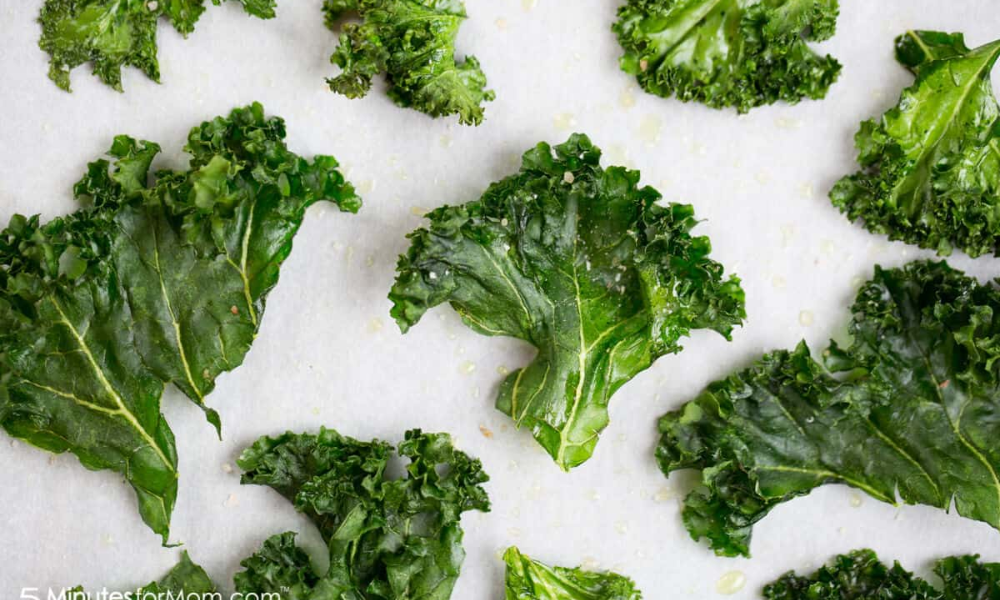Kale chips, which are ideal for snacking, are currently in style. Even if there are various brands of kale chips available on the market, there is no need to buy them. Chunky, crunchy “chips” made from hearty kale leaves may be made at home quickly and easily for a delicious snack. Any variety of kale will do, but lacinato (or “dino”) is the best. To make kale chips, you need two things: Bake them in a single layer for 20 minutes, then take them out to allow them to cool completely. They will continue to crisp up as they cool. If you cook them until they are already crisp, they will scorch and get a burnt taste when they cool.
How to Cook Kale Chips?
Before removing the stems, the kale must first be cleaned, dried, and torn into smaller pieces. The kale is then rubbed with oil and your preferred seasonings. Because of this recipe’s adaptability, you can change it to incorporate any flavours or herbs you like, and I list a few possibilities below.
After that, the seasoned kale is placed on baking sheets, careful to have as little contact as possible. The kale becomes crisp due to this. Stir carefully, then bake for an additional five minutes after the initial 15 minutes. You want it to be crispy and just a little bit golden brown.
But keep an eye out to avoid scorching! When the kale chips are taken out of the oven, letting them cool on the baking pans will help them become even crispier. You can put them back in the range at a lower temperature or while it’s off but still warm if they haven’t been crisp, and the cooler temperature will aid in evaporation and promote crispness!
Ingredients
- One substantial bundle of curly purple or green kale
- Melted coconut or avocado oil, 1-2 Tbsp
- selections of seasonings (For example, a sprinkling of sea salt,
- one tablespoon of nutritional yeast, one teaspoon each of cumin,
- chilli powder, curry powder, one giant bundle of kale, etc.)
Instructions
- Set oven to 225 degrees Fahrenheit (107 C). If you have a convection oven, use it to shorten the cooking time and make the chips even crispier.
- Kale should be carefully rinsed, dried, torn into little pieces, and any large stems should be thrown away.
- Add to a sizable mixing bowl, then season to taste with oil. Use your hands to properly distribute the oil and seasonings while thoroughly combining the ingredients.
- To help the kale crisp up during baking, spread it out evenly on two big baking sheets (you can use fewer or more if you want to change the batch size).
- To achieve equal baking, turn the pans around after 15 minutes of baking and lightly stir or toss the kale. Kale should be crispy and just golden brown after an additional 5 to 10 minutes of baking, and it can burn quickly, so keep an eye on it.
- After being taken out of the oven, the chips will get even more crispy. Remove and let cool somewhat.
- Enjoy right away! Fresh is ideal. For two to three days, keep leftovers covered at room temperature.
How do you Make Kale Chips Less Bitter?
After experimenting with three different settings, we determined that 250°F was the ideal cooking temperature. The kale chips crisp up nicely at this temperature without becoming burnt or bitter. Ensure your kale chips do not overlap one another in the pan so that air can circulate around and between them. This makes sense because we typically use high heat when we want something crispy. However, the kale tends to get chewy or undercooked in the thicker sections at this temperature while becoming brittle, brown, and bitter in the thinner areas.
Salt, olive oil, and minced garlic are inexpensive components that can enhance the flavor of a dish with bitter kale. The bitterness of kale can be lessened by chopping the stem and marinating it in salt and olive oil. Kale chips are a delectable substitute for potato chips, and seasoning makes them even better. There are some fantastic ideas for transforming kale chips into great midday snacks, but there are no “laws” to flavoring kale chips. For Super Bowl season and party munchies, try nacho “cheese” kale chips.
Why is my Kale Chips Soggy?
The water can “steam” the kale chips during baking if the leaves aren’t thoroughly dried, resulting in the dreaded mushy kale chip. Before massaging the oil in, make sure they are scorched. It works lovely to use a salad spinner, but watch out not to overload it so the leaves can dry up completely. Some kale chip enthusiasts swear by keeping their chips in a paper bag at room temperature.
The extra moisture is absorbed by the paper, preventing the chips from becoming soggy. If you decide to use the paper bag technique, make sure you securely roll the top of the bag to block out as much air as you can. Place the bag in a dry location, such as a pantry. It’s crucial to allow them to cool if you want them to stay crispy.
They can be chilled for 2-3 days in an airtight container at room temperature. You might also try including a few raw rice grains or silica packets in the airtight container (similar to those found in store-bought kale chips). It & Ideal for munching!
Before placing the chips in serving bowls or storing them in paper bags, let them cool. The chips can be vacuum-sealed in plastic for long-term storage if you have a vacuum sealer once they have cooled. Otherwise, storing them in paper bags instead of plastic ones will help them retain their crunch longer. Refrigerate not.
Are Kale Chips Healthy?
And unlike potato chips, kale chips keep their nutritious worth. Vitamin A, calcium, potassium, vitamin C, vitamin E, fiber, and antioxidants are all abundant in kale. The tiny amounts of olive oil and salt used in this recipe scarcely increase its fat- and sodium-free content. You can eat a lot of kale chips without adding many calories to your diet because they have a low energy density (Mayo Clinic, 2014).
This makes them the ideal food for weight loss because they enhance your energy levels without causing you to gain weight. Kale is a healthy option for the heart because it has no cholesterol and no harmful saturated or trans fats.
A good source of heart-healthy monounsaturated fats can be found in the olive oil that you use to make kale chips. For instance, if used in very high doses, it may interfere with thyroid function. It contains a substance called progoitrin, which can obstruct the iodine your thyroid needs to function and disrupt the production of thyroid hormones.
Weight changes and variable blood sugar levels may follow from this. Kale is becoming increasingly popular, whether fried into chips, added to salads, or simmered into a filling vegetable meal. These deep green leaves are nutrient-rich, although some may have trouble digesting them. Dietary fiber and some sugars in kale can be challenging for your digestive system.
What do you Serve with Kale Chips?
Kale chips can be eaten plain with a sprinkling of sea salt, spiced with cayenne pepper for a hot snack, dipped in hummus for a protein boost, or accompanied by ranch dressing or spinach artichoke dip. I’ve always thought the extra work was worthwhile, and I count the finished product as a vegetable even if it requires a bunch of kale and two baking pans to make four servings. After all, I use roughly the same amount of oil and salt to make them as if I were sautéing the greens.
The poop-boosting minerals found in spinach, Swiss chard, and kale include fiber (1 cup of Swiss chard has 4 grams of fiber), magnesium (which helps the colon contract), and potassium (which helps control fluid balance and muscle contractions). This is due to the high sulfur content in cruciferous vegetables like kale, broccoli, and cauliflower. In the large intestine, sulfur’s chemical component is broken down to create the gas hydrogen sulfide. It can also result in highly unpleasant flatulence, sometimes compared to rotten eggs’ stench.
How can Kale be Cooked Without Losing its Nutrients?
To soften food, stir it briefly in a small amount of water or oil. Sauté: Stir food for several minutes while cooking it in oil over high heat. Blanching is briefly immersing food in boiling water and cooling it in cold water. Cook food using steam, typically using a steamer basket. Therefore, steaming kale for a short period may be the ideal method to maintain its healthy levels for individuals who love cooked kale. Kale is very nutrient-dense, a food rich in vitamins, minerals, and antioxidants.
However, cooking kale reduces its nutritional content. This does not imply that cooked kale chips lose all of their vitamins. The kale chips still have a lot of vitamins, minerals, and nutrients after baking. Said, the portions are smaller than when eaten raw. In addition, heating kale does not eliminate its nutritional benefits, despite popular belief. Kale loses its water content when baked, making it dry and crispy.
Conclusion
First, trim the kale of any thick ribs and thorny stalks. However, you shouldn’t include them when making the chips; you may reserve them for stock or another use. The kale should be chopped into smaller pieces since roasting causes it to shrink somewhat. Next, thoroughly rinse and dry the kale. In this recipe, the kale needs to be as dry as possible.
Kale will steam if it is still wet when baked, producing floppy kale instead of crispy kale. Use a salad spinner if you have one to spin all the water out. Alternately, gently dry with some paper towels or a brand-new kitchen towel. Before baking, toss the kale with a bit of salt and olive oil; alternatively, use your preferred oil. After baking, we advise more seasoning the chips if you plan to.

